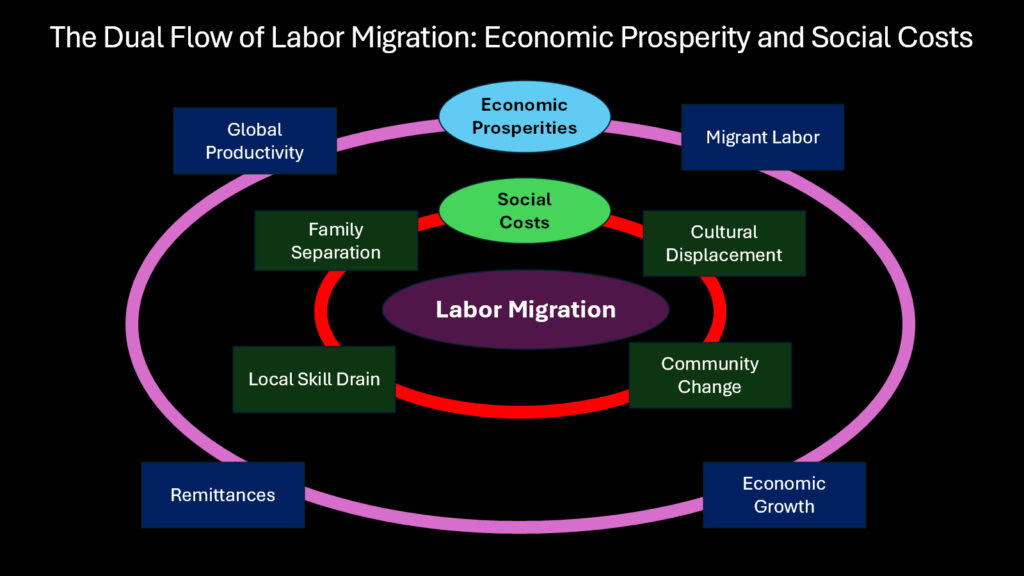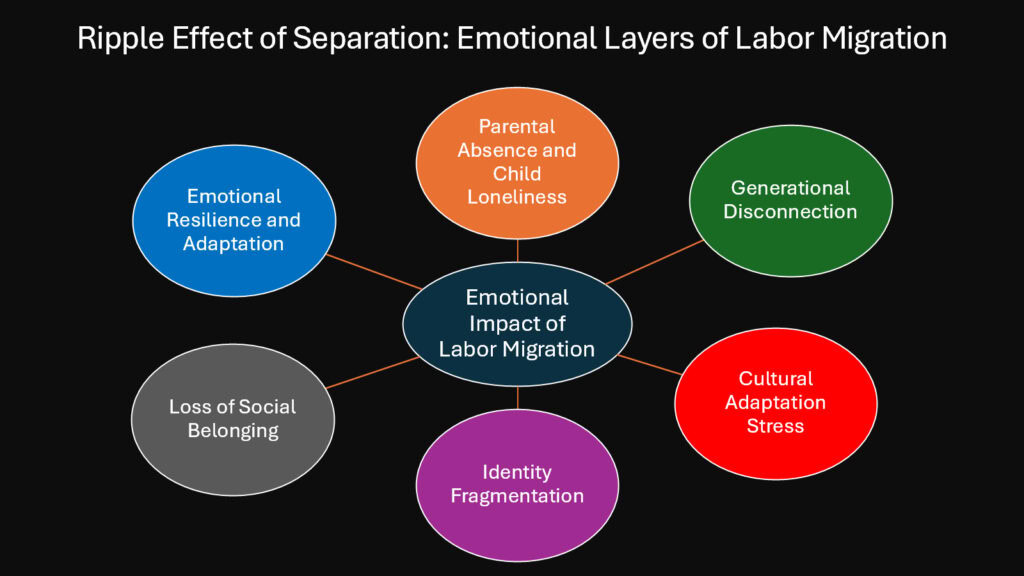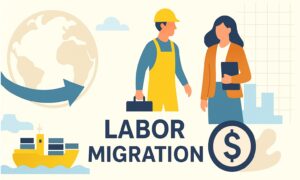Table of Contents
Introduction: The Dual Reality of Labor Migration in the Global Economy

Labor migration has become the circulatory system of modern capitalism. Workers cross borders in unprecedented numbers, filling labor shortages in prosperous nations while sending billions back home. This movement shapes economies in ways that trade agreements and investment flows cannot replicate. Yet beneath the success stories lies a complex reality that rarely makes headlines.
The global economy depends on labor migration as much as it depends on open trade routes or digital infrastructure. Hundreds of millions of workers leave their homelands seeking better wages. Their labor builds cities, staffs hospitals, harvests crops, and powers factories across the developed world. The money they send home keeps entire regions afloat, funding education and healthcare where governments struggle to provide basic services. But this system extracts hidden costs that economic models often ignore.
These costs manifest in villages where entire generations have vanished. They appear in families stretched across continents, connected only by irregular video calls. They emerge in economies that survive on remittances rather than building productive industries. The paradox is striking: labor migration creates prosperity in some places while quietly hollowing out the foundations of growth in others. This article explores six hidden costs that accompany the global movement of workers, looking beyond the economic benefits that dominate policy discussions.
Labor Migration and Global Economic Building Blocks
| Global Economic Building Blocks | Relationship with Labor Migration |
|---|---|
| Global Trade | Migrant workers enable export industries by providing flexible labor pools that respond to demand fluctuations |
| Global Financial Systems | Remittance flows constitute a major cross-border channel, exceeding foreign investment in many developing economies |
| Technology and Innovation | High-skilled labor migration facilitates knowledge transfer but creates innovation gaps in origin countries lacking technical talent |
| Natural Resources and Energy | Extractive industries rely heavily on labor migration for operations in remote locations with insufficient local workforce availability |
| Governance and Institutions | Labor migration patterns reveal institutional weaknesses and policy failures while challenging regulatory frameworks across borders |
| Geopolitics | Labor flows influence diplomatic relationships, creating economic dependencies and political leverage between sending and receiving nations |
| Global Supply Chains | Multinational production networks depend on migrant workers to maintain cost competitiveness and operational flexibility |
| Demographics | Migration alters population structures, addressing aging crises in developed nations while accelerating transitions in developing countries |
| Climate and sustainability | Climate and sustainability shifts influence labor migration by displacing workers from vulnerable regions toward more resilient and resource-stable economies. |
1. Labor Migration and the Erosion of Local Workforce Stability
When workers leave their home countries in large numbers, they create vacancies that cannot be easily filled. This outflow disrupts the stability of entire sectors and regions. The World Health Organization has documented how the healthcare worker exodus leaves origin countries struggling with severe staff shortages. Rural regions across Mexico, Central America, and Southeast Asia have seen farming populations decline as young workers seek employment abroad, creating labor shortages during critical planting and harvest seasons.
The construction and manufacturing sectors face similar challenges. Poland experienced this after joining the European Union, when construction workers moved westward in large numbers. The resulting shortage drove up labor costs and slowed housing development. Local employers find themselves competing with foreign wage offers they cannot match. A teacher in Sub-Saharan Africa might earn more as a domestic worker in the Gulf states than in their profession at home.
The erosion of workforce stability affects business planning and investment decisions. Companies hesitate to invest in training when workers are likely to emigrate. This uncertainty slows economic diversification and keeps origin countries locked in low-value activities. The long-term consequence is an economy dependent on exporting human capital rather than building industries that could employ it productively at home.
Porter’s Five Forces Analysis: Labor Migration Impact on Origin Country Markets
| Competitive Force | Impact of Labor Migration |
|---|---|
| Threat of New Entrants | Reduced as skilled labor shortages increase barriers to establishing competitive businesses in affected sectors |
| Bargaining Power of Suppliers | Enhanced for labor recruitment agencies and training institutions that facilitate migration pathways |
| Bargaining Power of Buyers | Decreased for employers who must offer higher wages and better conditions to retain remaining workers |
| Threat of Substitutes | Increased pressure to automate or outsource functions as human capital becomes scarce and expensive |
| Industry Rivalry | Diminished as labor shortages constrain expansion plans, reducing competition intensity within domestic markets |
| Quality of Human Capital | Degraded as most skilled and ambitious workers depart, leaving less qualified workforce for local industries |
| Regulatory Environment | Strained as governments attempt to balance freedom of movement with economic development needs |
| Long-term Competitiveness | Compromised by inability to develop complex industries requiring stable access to skilled labor pools |
2. Labor Migration’s Emotional Toll on Families and Generations

The economic calculus of migration rarely accounts for the emotional devastation it leaves behind. Children grow up with parents who exist mainly as voices on phone calls and faces on screens. Research on transnational families reveals the psychological cost of this separation. Children raised by grandparents or other relatives while parents work abroad often struggle with feelings of abandonment.
The migrants themselves carry profound emotional burdens. Domestic workers from Indonesia or Ethiopia who care for children in wealthy households often leave their own children behind. They nurture other people’s families while missing the developmental milestones of their own. Marriages face particular strain under the weight of distance. Spousal relationships conducted through video calls struggle to maintain intimacy and trust.
Elderly parents left behind face their own isolation. Traditional family structures in many cultures expect children to care for aging parents. Migration inverts this expectation. Older people find themselves alone in villages emptied of youth, dependent on remittances but deprived of companionship. This emotional toll extends across generations, creating multigenerational cycles of family separation.
Labor Migration: Transnational Family Challenges and Manifestations
| Family Dynamic | Migration-Induced Challenge |
|---|---|
| Parent-Child Bonding | Physical absence during critical developmental years weakens attachment and creates psychological distance |
| Marital Relationships | Extended separation strains intimacy and trust, increasing vulnerability to relationship breakdown |
| Sibling Connections | Children left behind may struggle to integrate returning migrant siblings into family dynamics |
| Elder Care Responsibilities | Traditional caregiving expectations become impossible to fulfill, creating guilt for migrants and vulnerability for aging parents |
| Decision-Making Authority | Confusion over who holds parental authority when remittance-sending migrants live abroad |
| Identity Formation | Children develop hybrid identities shaped by absent parent’s culture and local guardian’s values |
| Emotional Support Systems | Family members cannot provide immediate comfort during crises, relying on delayed communication |
| Reintegration Challenges | Returned migrants struggle to reconnect with children and spouses who have adapted to their absence |
3. Labor Migration and the Brain Drain Dilemma in Emerging Economies
The departure of educated professionals represents one of the most consequential costs of labor migration. Countries invest heavily in educating their citizens only to watch them contribute to other economies. African nations lose significant percentages of their university graduates to migration. Small island developing states see their most educated citizens leave in such numbers that maintaining professional services becomes nearly impossible.
The impact on innovation and development is profound. Countries cannot build knowledge economies when their knowledge workers emigrate. Research institutions struggle to retain faculty members. Healthcare systems collapse when doctors depart faster than medical schools can train replacements. The result is a permanent development gap that foreign aid and remittances cannot bridge.
Brain circulation offers theoretical hope, but these successes remain exceptional. The wage gaps that drive initial migration persist over time. A software engineer might earn ten times more in Silicon Valley than in Bangalore. The brain drain also reinforces global inequality. Developed nations benefit from education systems they did not fund, gaining workers in their prime productive years without bearing the costs of raising and educating them.
Labor Migration and Brain Drain Impact Matrix: Sector-Level Consequences
| Professional Sector | Consequences of Talent Migration |
|---|---|
| Healthcare Services | Critical shortages of doctors and nurses compromise disease prevention, maternal care, and emergency response |
| Higher Education | Universities cannot maintain research programs or teaching quality when faculty depart |
| Technology Development | Software engineers emigrate before building domestic tech industries, delaying digital transformation |
| Public Administration | Loss of experienced civil servants weakens governance capacity and institutional memory |
| Financial Services | Banking professionals leave for international firms, limiting sophisticated financial sector development |
| Legal Professions | Trained lawyers and judges migrate, creating justice system backlogs and reducing rule of law effectiveness |
| Engineering Infrastructure | Civil engineers depart, forcing countries to hire expensive foreign consultants for development projects |
| Scientific Research | Researchers pursue opportunities abroad where funding is available, preventing indigenous scientific advancement |
4. Labor Migration’s Unequal Gains Across Global Markets

The benefits of labor migration flow unevenly across the global economy. Destination countries gain productive workers during their peak earning years while avoiding education costs. Germany’s welcoming of skilled workers from Southern and Eastern Europe exemplifies this dynamic. German industries benefit from workers educated at other countries’ expense, while Romania and Bulgaria face workforce shortages.
The United States immigration system similarly captures global talent. Tech companies recruit engineers from India and China to maintain their competitive edge. This talent concentration reinforces American technological leadership while limiting innovation potential in origin countries. Wage inequality between migrants and native workers reveals another dimension of unequal gains. Many migrants accept lower wages for comparable positions due to discrimination and limited bargaining power.
Japan’s experience with technical interns illustrates how destination countries structure migration to maximize benefits while minimizing obligations. The trainee system officially aims to transfer skills but functions as a source of low-cost labor. The remittance-for-labor exchange represents an unequal trade where sending countries export their most productive citizens and receive cash transfers in return.
Comparative Analysis: Gains by Stakeholders Due to Labor Migration
| Stakeholder Category | Primary Gains from Migration |
|---|---|
| Destination Country Employers | Access to flexible, often lower-cost labor that fills workforce gaps without long-term obligations |
| Destination Country Governments | Increased tax revenue and enhanced demographic profile without education investment |
| Destination Country Consumers | Lower prices for services and goods produced by migrant labor in agriculture and construction |
| Individual Migrants | Higher wages and better living standards despite hardships and exploitation risks |
| Origin Country Families | Remittance income enabling consumption, education, and healthcare exceeding local earning potential |
| Origin Country Governments | Foreign exchange earnings and reduced unemployment pressure but loss of productive citizens |
| Recruitment Agencies | Profits from placement fees and services connecting migrants with foreign employers |
| Financial Institutions | Transaction fees from remittance transfers constituting a growing revenue stream |
5. Labor Migration and the Rise of Economic Dependency on Remittances
Remittances have become a lifeline for many developing economies. The World Bank reports that these transfers exceed official development assistance in many countries. This dependency carries significant risks. Remittances fluctuate with economic conditions in destination countries. The Philippines experienced this during the global financial crisis when remittances declined, affecting millions of households.
The availability of remittances can reduce incentives for domestic economic development. Governments that balance budgets through remittance-generated taxes may neglect industrial policy and job creation. This complacency perpetuates underdevelopment even as remittances mask symptoms of economic weakness. Young people see migration as more attractive than pursuing education or entrepreneurship at home.
Mexico offers a telling example of remittance dependency. Several states receive transfers that constitute substantial portions of their economic activity, yet these regions remain among the poorest with limited industrial bases. The financial sector in remittance-dependent countries also reflects this dynamic. Banks compete for remittance transfers but may neglect lending to productive enterprises, focusing instead on consumer finance and real estate.
Labor Migration and Remittance Economy: Dual Impact Framework
| Economic Dimension | Positive Impacts | Negative Impacts |
|---|---|---|
| Household Poverty | Direct income support lifts families above subsistence | Dependence reduces motivation for local employment |
| Education Investment | Families fund schooling, increasing human capital | Educated youth follow earlier migrants abroad |
| Healthcare Access | Private healthcare spending becomes affordable | Government healthcare investment declines |
| Housing Development | Construction boom creates employment | Real estate speculation diverts resources from productive investments |
| Foreign Exchange | Remittance inflows stabilize currencies | Exchange rate appreciation harms export competitiveness |
| Financial Inclusion | Recipients gain access to banking services | Financial sector focuses on transfers rather than productive lending |
| Consumption Patterns | Increased spending stimulates local retail | Import-heavy consumption drains foreign exchange |
| Government Revenue | Indirect taxation supplements fiscal resources | Reduced pressure to implement tax reforms |
6. Labor Migration and the Cultural Fragmentation of Local Identities
Labor migration reshapes cultures in ways that extend far beyond economics. When significant portions of communities live abroad, traditional practices, languages, and values evolve under outside influences. Language offers the most visible marker of this shift. Children in migrant-sending communities often prioritize learning English over maintaining fluency in their mother tongues, knowing that language skills will serve them if they too migrate.
Religious and social practices also transform. Migrants return with different values shaped by years in secular or differently religious societies. Traditional celebrations lose participants and vitality. The diaspora communities that form in destination countries create their own hybrid cultures, maintaining transnational identities that belong fully to neither origin nor destination.
National identity becomes complicated when large percentages of citizens live abroad. Countries like Moldova or El Salvador have diaspora populations approaching or exceeding their domestic populations. Cultural fragmentation also manifests in generational divides. Young people raised in migrant households often feel disconnected from the cultures their parents knew, inheriting fragmented traditions without context.
Cultural Transformation Domains Under Labor Migration Pressure
| Cultural Dimension | Transformation Patterns |
|---|---|
| Language Vitality | Indigenous and regional languages decline as families prioritize dominant languages for economic opportunity |
| Religious Practice | Traditional religious observance adapts to diaspora contexts while homeland communities experience changing participation |
| Family Structures | Extended family systems weaken as nuclear and transnational family forms become normalized |
| Gender Roles | Women’s participation in migration challenges traditional gender norms, creating conflicts and gradual social change |
| Culinary Traditions | Food practices hybridize with diaspora influences while traditional ingredients become harder to maintain |
| Artistic Expression | Music and literature reflect transnational experiences, creating forms disconnected from purely local traditions |
| Collective Memory | Shared historical narratives fragment as diaspora and homeland communities develop divergent interpretations |
| Social Cohesion | Community bonds weaken when population turnover is high and social networks span continents |
Conclusion: Rethinking Labor Migration for a Sustainable Global Future

Labor migration stands at a crossroads. The current system generates enormous wealth while distributing costs and benefits unequally. Destination countries prosper from talent they did not cultivate. Migrants sacrifice family closeness for wages that barely compensate for what they surrender. Origin countries collect remittances while losing the human capital that might generate lasting prosperity.
The six hidden costs reveal how deeply labor migration penetrates societies and economies. Workforce erosion, family separation, brain drain, unequal gains, remittance dependency, and cultural fragmentation operate simultaneously, each reinforcing the others. Rethinking migration requires moving beyond simplistic win-win narratives and acknowledging that current patterns reflect global structures that privilege capital mobility over human welfare.
Policy reforms should focus on circular migration models that allow workers to move temporarily without severing ties to home communities. Origin countries need support developing industries that can retain educated citizens. Trade agreements should include labor mobility provisions that protect worker rights. Currently these agreements privilege corporate interests while treating labor as a domestic concern each nation must manage alone.
Ultimately, reducing migration pressures requires addressing the inequalities that make moving necessary. Development assistance should focus on job creation rather than simply providing social services. Technology transfer could help poorer countries build productive economies. The global economy needs labor migration, but the question is what kind of system will emerge. Will it continue extracting value from vulnerable populations or can policy makers create frameworks that preserve human dignity while enabling prosperity? Labor migration, understood in its full complexity including its hidden costs, offers a window into the values that shape our economic future.
Policy Priorities for Equitable Labor Migration Systems
| Policy Domain | Strategic Priority |
|---|---|
| Legal Frameworks | Establish temporary and circular migration pathways that maintain family connections while meeting labor demands |
| Labor Standards | Enforce equal pay and working conditions for migrants, eliminating exploitation |
| Development Finance | Redirect remittances toward productive investments through matching programs and entrepreneurship support |
| Brain Circulation | Create incentives for diaspora engagement and return migration through research funding |
| Social Protection | Extend portable benefits covering healthcare and pensions across borders for migrant workers |
| Cultural Preservation | Support language education and cultural maintenance programs in diaspora communities |
| Regional Integration | Develop migration agreements that allow free movement while establishing minimum standards |
| Data Transparency | Improve migration statistics to inform evidence-based policies rather than responding to political pressures |




